For many geeks, Bletchley Park is known as the place where mathematician Alan Turing and his team of codebreakers worked tirelessly to crack the Nazi Enigma cipher. But this former British estate-turned-secret-military-headquarters was home to more than just Turing and his team. At the height of the World War II, more than 9,000 people lived and worked on the 58-acre compound, and the people working there did a lot more than crack the Enigma cipher. They also deciphered many secret communications sent by the different military branches of the Axis powers–including the Lorenz cipher, the Engima’s more complicated cousin. It’s hard to overlook the fact that’s repeated on many signs throughout the museum: the work done at Bletchley Park shortened World War II by at least two years.
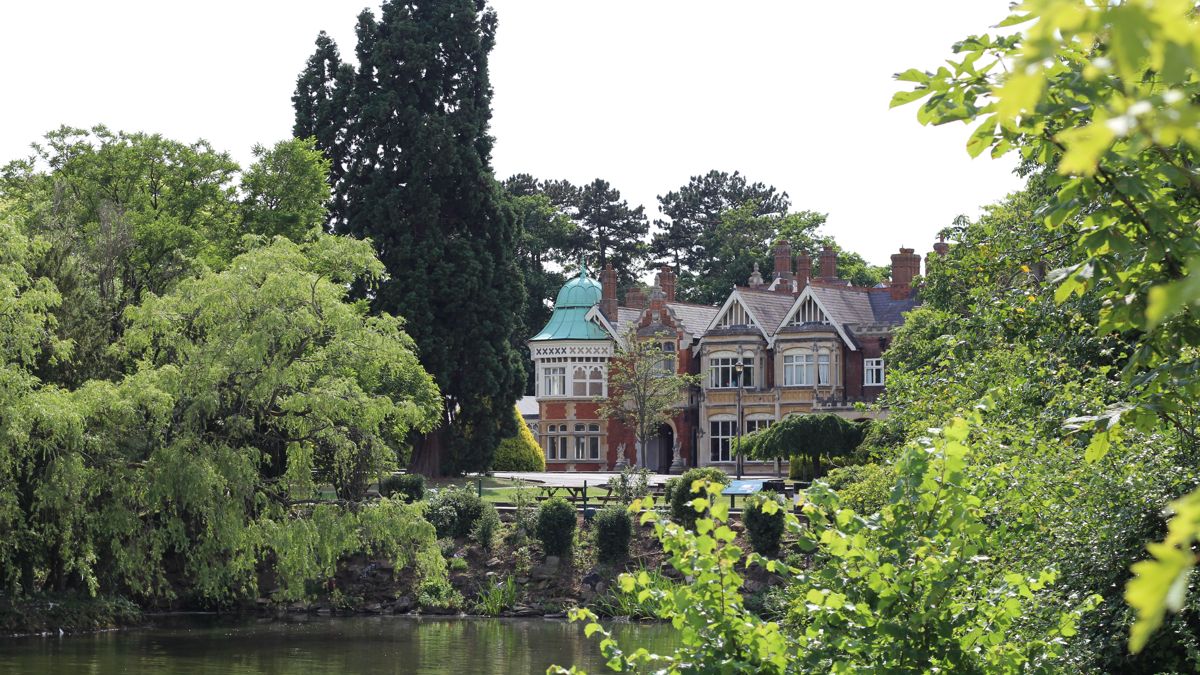
The estate that would become Bletchley Park dates way back to the early 1700s, but its status as codebreaker central began when Admiral Sir Hugh Sinclair bought the property on behalf of the British government in 1938. It was purchased and developed for the express purpose of housing the Secret Intelligence Service (also known as MI6–the organization James Bond works for) and the Government Code and Cypher School (GC&CS). The cryptographers housed here started work on breaking enciphered Nazi messages the day after Britain and France declared war on Germany in 1939.
Bletchley Park is located just an hour-and-half drive (or a 40-minute train ride) north of London in the town of Milton Keynes, and our family stopped to visit the place on our drive from London to Hadrian’s Wall. I’ve long been a fan of codes and ciphers, so I was really excited to finally be able to visit such an important monument in the history of cryptography.
After paying the price of admission, we were given a copy of Home of the Codebrakers Guidebook and invited into the hallowed grounds of Block C by a fellow sporting a cipher-decorated necktie (codes and ciphers lurk around every corner at Bletchley Park).
Block C
By the end of World War II, the Bletchley Park complex held eight different Blocks made of bomb-proofed brick and concrete, lettered A-H. Today, Block C is the museum’s Visitor Centre and serves as the introduction to Bletchley Park. It features a number of different exhibits, including the aptly named “Secrets Revealed–Introducing Bletchley Park” and the “Road to Bletchley Park,” where visitors learn about the history of codebreaking and the codebreakers of World War I who set the stage for the success of the Bletchley Park.
There’s a self-guided path that gives visitors an overview of the codebreaking process, and it’s here that visitors learn the difference between codes and ciphers. As explained on a plaque:
A code is when words, phrases, or numbers are converted into other words, phrases, or numbers. For example, the phrase attack at dawn might be encoded to read buy some milk. Conversely, a cipher changes individual letters or small groups of letters into other letters or numbers. Using the same example, attack at dawn, might be enciphered to read bpyfw wgzxg qsvrp.
In Block C visitors also get their first look at an actual Enigma machine, the device used by the Axis powers to send secret communiqués.
Enigma Machine
The first Enigma machine was invented by Arthur Scherbius, a German mechanical engineer and appeared in 1923, showcased by his company Scherbius & Ritter. It was originally designed to be used for commercial purposes–keeping bank information and other trade secrets secure–but it quickly attracted the attention of various European intelligence agencies.

By 1932, a more advanced, military-grade version of the Engima appeared on the cryptographic scene that was able to encipher a message in 159 million million million different ways. The job of the Bletchley Park codebreakears was to discover how each letter in a given cipher had been transformed so it could be deciphered–not an easy task. But they had a little help from careless Enigma operators who took shortcuts while enciphering messages and a flaw in the device itself–no letter could ever encipher itself.
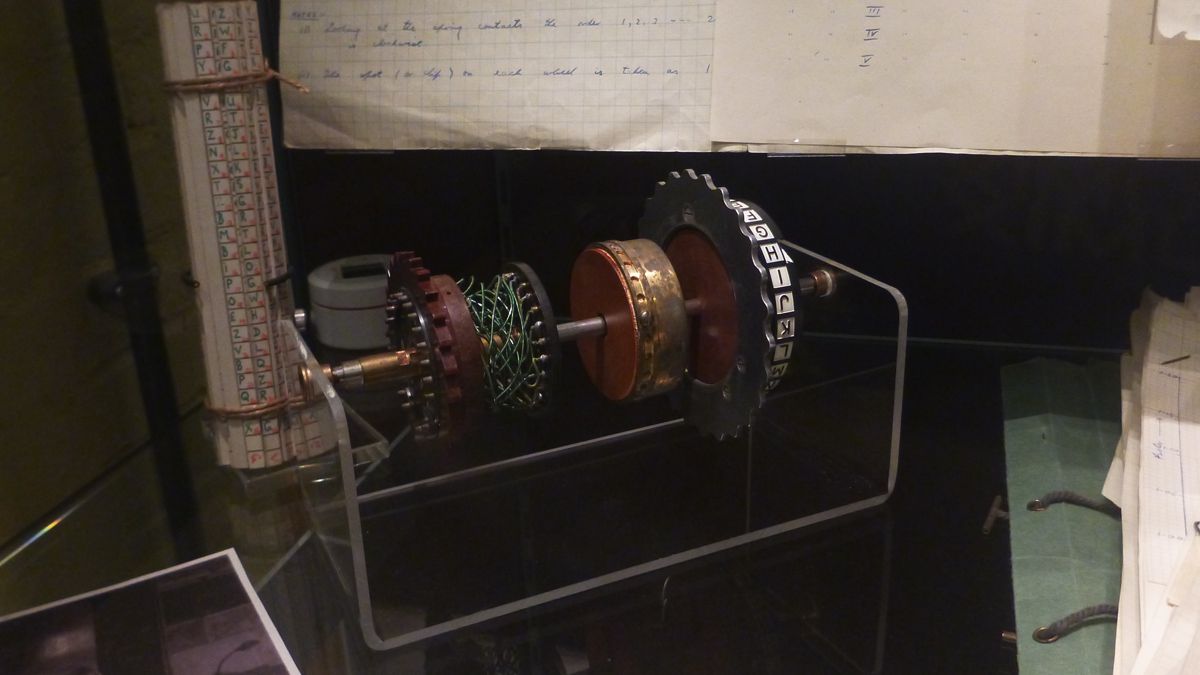
Block C displays a few Enigma machines and select parts that accompany some really cool computer-aided diagrams and interactive stations helping to explain how the Enigma machines worked and how the codebreakers were able to crack the Enigma cipher.
Block B
There didn’t seem to be a set tour to take at Bletchley Park, and once we left Block C, we were free to roam anywhere on the estate. But, because we arrived a little late in the day, we were advised to head over to Block B, which is marked by the Codebreaker Monument erected in 2011, before the museum closed.

Block B is where many exhibits and galleries relating to wartime at Bletchley Park are housed–including the largest public display of Enigma machines in the world and a real, working Bombe machine.
Bombe Machine
The Bombe machines were electromagnetic computers that functioned as super-Enigma decryptors. The first Bombe machine was built in March 1940, and by August 1940 Alan Turing and his team had constructed better versions of the Bombes. They operated with a system of color-coded cylinders, and a typical Bombe replicated 36 enigma machines and could run up to three deciphering jobs simultaneously.
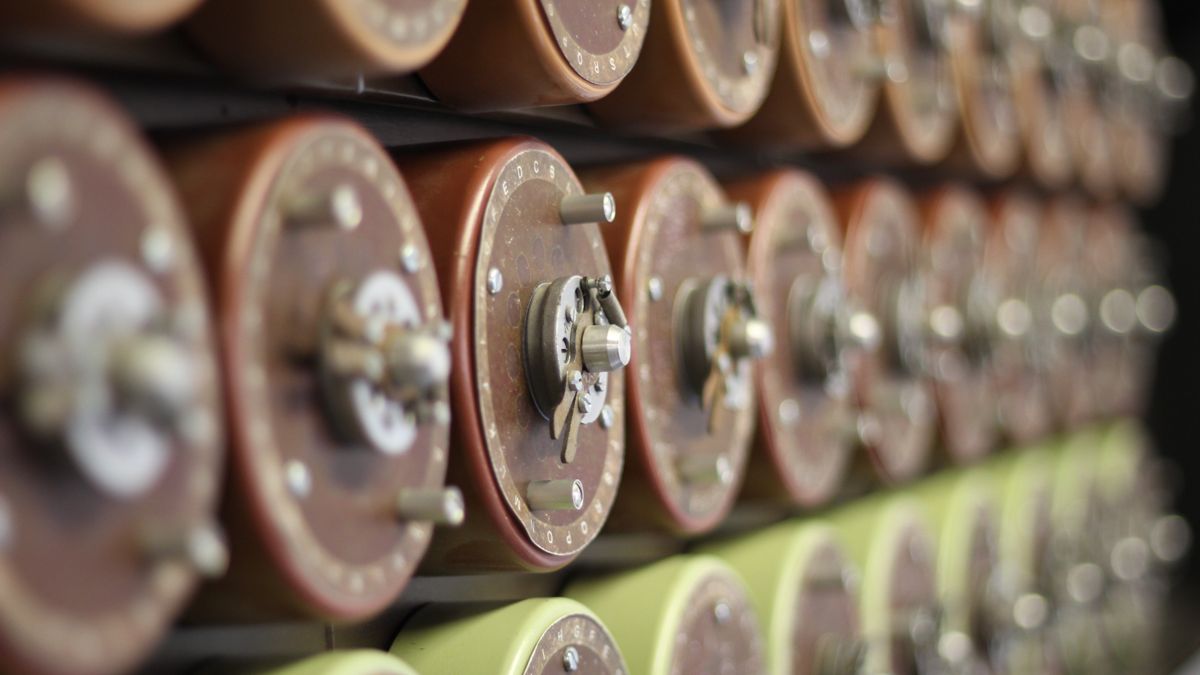
Although the deciphering still took a lot of time–and a human was needed to interpret the output–the work the Bombes did sped up the team’s ability to break the ciphers on individual messages.
For some reason, all the British Bombes were destroyed at the end of the war. However, thanks to the “Turing Bombe-Rebuild Project,” which took 13 years to complete, there’s a working Bombe machine in the basement of Block B. While we were there, one of the docents was giving a really thorough walkthrough of how the machines worked followed by a demonstration.
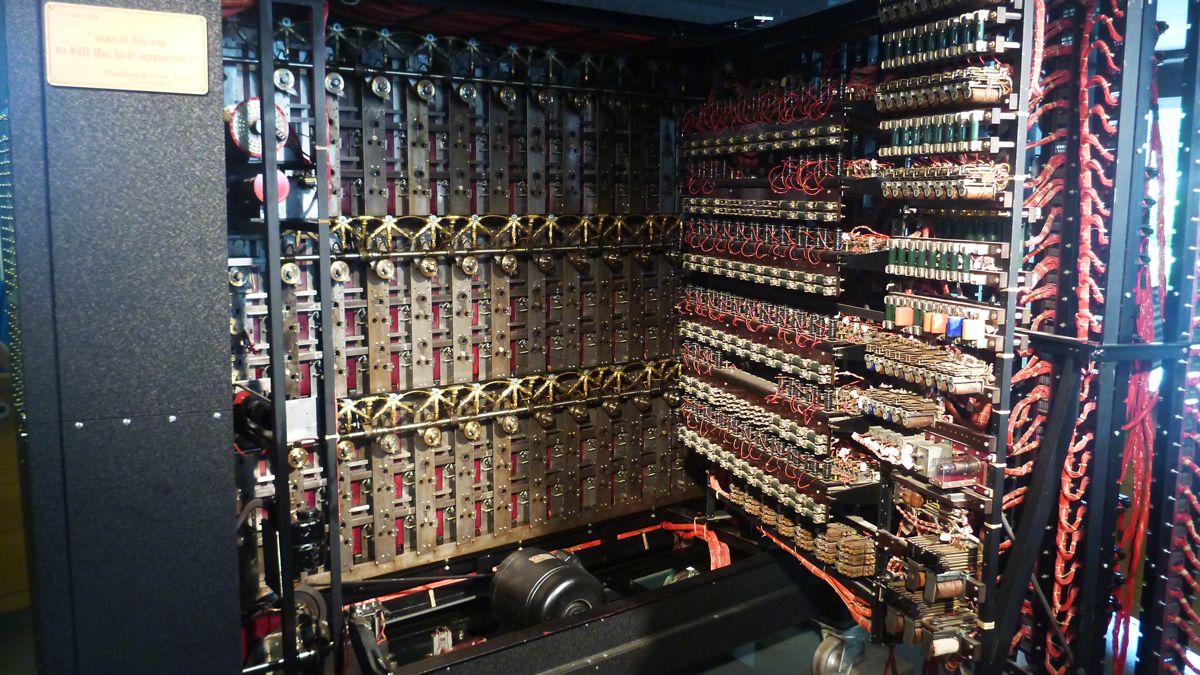
The single machine was really loud–I can only imagine what a whole room of them sounded like when running at full capacity. It was a fascinating look back at the history of computing.
Lorenz Machine
The Enigma cipher gets all the press, but it was the Lorenz cipher that gave the codebreakers at Bletchley Park even more trouble. Developed in 1940 as a more complex successor to Enigma–a Lorenz machine with 12 rotors was cable of enciphering a message 1.6 x 1019 different combinations. It was the cipher used by Hitler, the German High Command, and the German Field Marshals, and it was thought to be unbreakable.
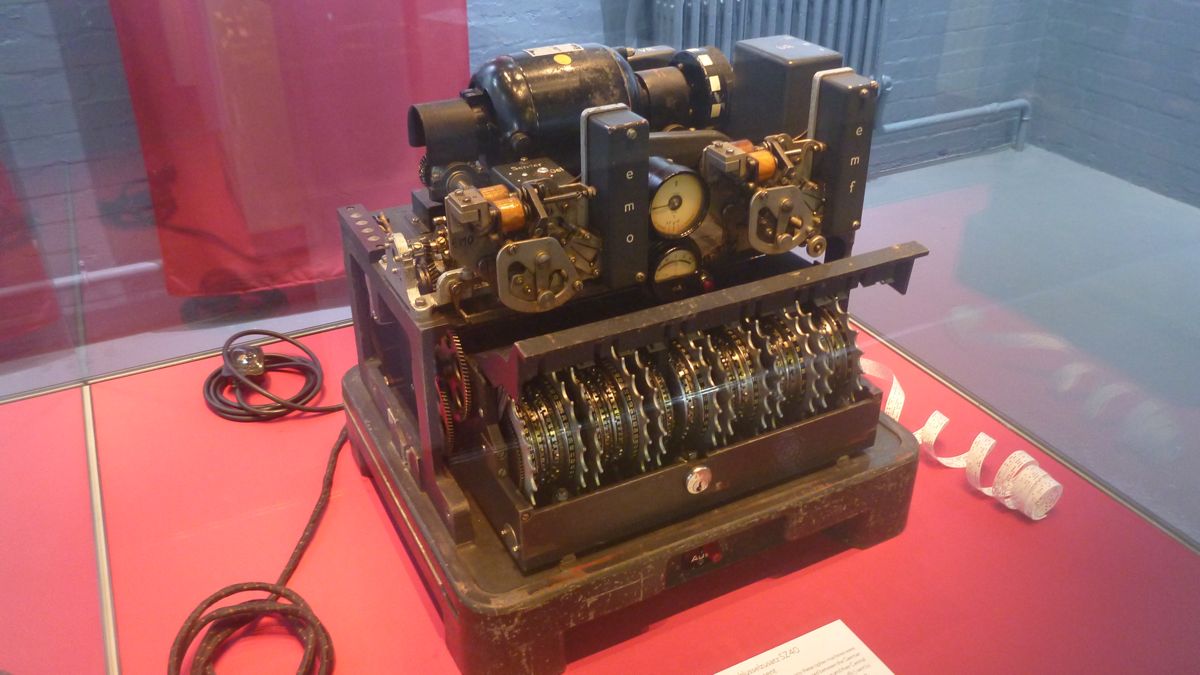
However, the codebreakers at Bletchley Park were able to crack the Lorenz cipher without ever seeing an actual Lorenz machine. This happened because of human error. In 1941, someone violated protocol by sending the same 4,000-word message twice with the same cipher. But there were minor differences in the messages (the sender abbreviated some words in the second sending), and this was all the data Bletchley Park needed to crack the cipher.
Despite this break, it was still very time-consuming to decipher a message sent with the Lorenz cipher. So, much like the Bombe machine aided deciphering of the Enigma code, another device–named Colossus–was built to help decipher the challenging Lorenz more quickly.
Colossus Computer
The first Colossus was built in 1943 and was fully operational in the early days of 1944, making it the world’s first programmable electronic computer (predating ENIAC by two years). By the end of the war, there were ten Colossus computers working around the clock deciphering these complex Lorenz messages.
There are a number of other displays in Block B, including a section on what life was like for the people living at Bletchley Park during the war, a section on the people who were working on breaking the codes used by the Japanese, and an extensive look at Alan Turing, the mathematician and cryptographer who headed up the team in charge of breaking the German Naval Engima messages.
Life and Works of Alan Turing
Alan Turing is known today as the father of modern computing, and not just because of his work in cryptography and on the Bombe machine. After the war, Turing was influential in developing computer systems (including the Automatic Computing Engine and the Manchester Mark I) and secure voice communications systems. In 1949 he proposed the now-famous Turing test as a means to measure and define artificial intelligence in machines.
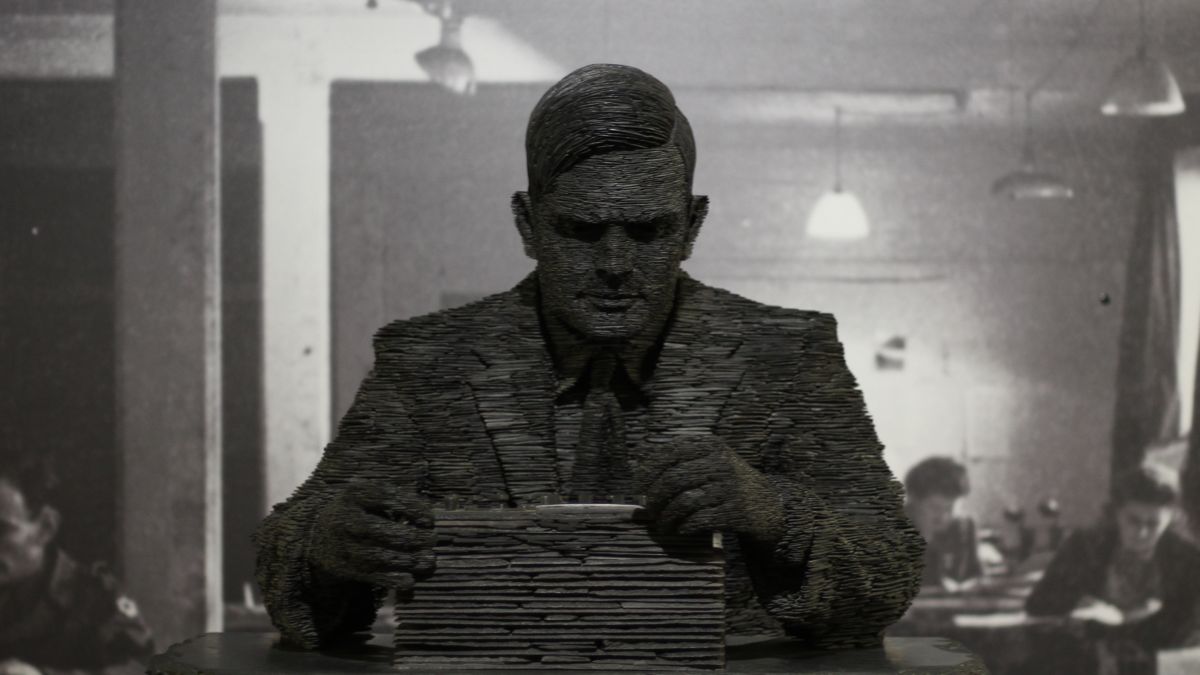
But the story of Alan Turing has a tragic ending. In 1952 he was convicted of indecency after he admitted to being gay, something that was illegal in Britain in those days. And then this man, who was so influential in helping the Allied forces win World War II, was stripped of his security clearance and forced to undergo hormone treatments by the British government. He ultimately ended his life two years later at the age of 39.
In recent years, Britain has started to make amends for their treatment of Turing and recognize his contributions, and he was granted a full pardon in late 2013–more than 60 years after his conviction.
Codebreaking Huts
In addition to its eight Blocks, Bletchley Park had as many as 23 “Huts” where different teams of codebreakers worked. These were all narrow buildings constructed wood. Most of them were painted green.
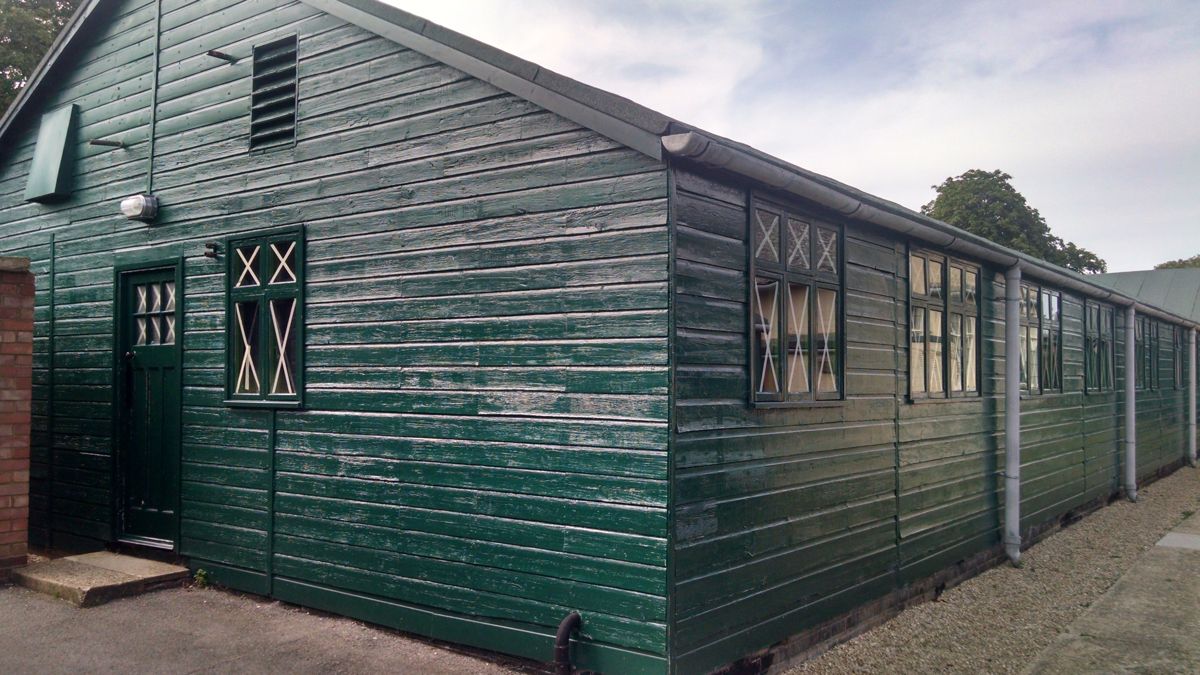
Inside each Hut, a single hallway ran the length of the building and was lined with doors on both sides that lead to private offices.
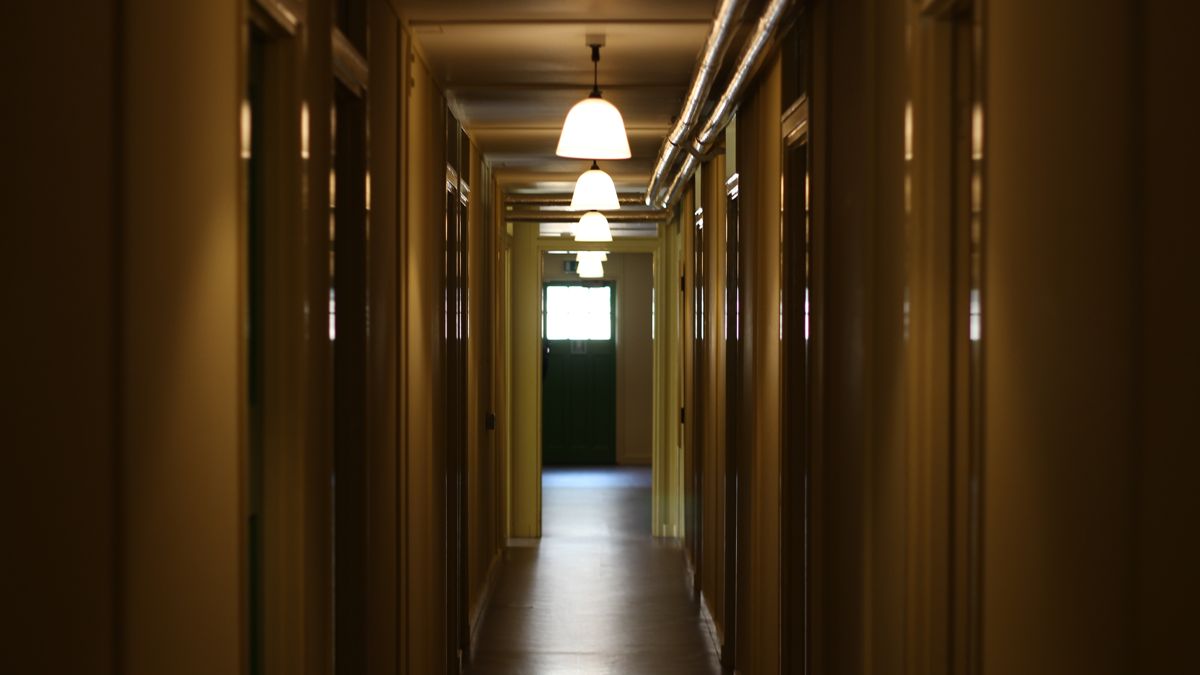
Of all the Huts, Hut 8 is the most famous.
Hut 8
This is the Hut where Turing’s team did the work that eventually cracked the Enigma cipher. It now holds an interactive exhibit called “Brilliant Minds” that demonstrates how the different codebreaking processes worked from start to finish. We even got to try out our skills at cracking ciphers, which was great and challenging fun. But I really enjoyed seeing the real office of Alan Turing, restored to what it might have looked like at the height of the codebreaking efforts in the 1940s.
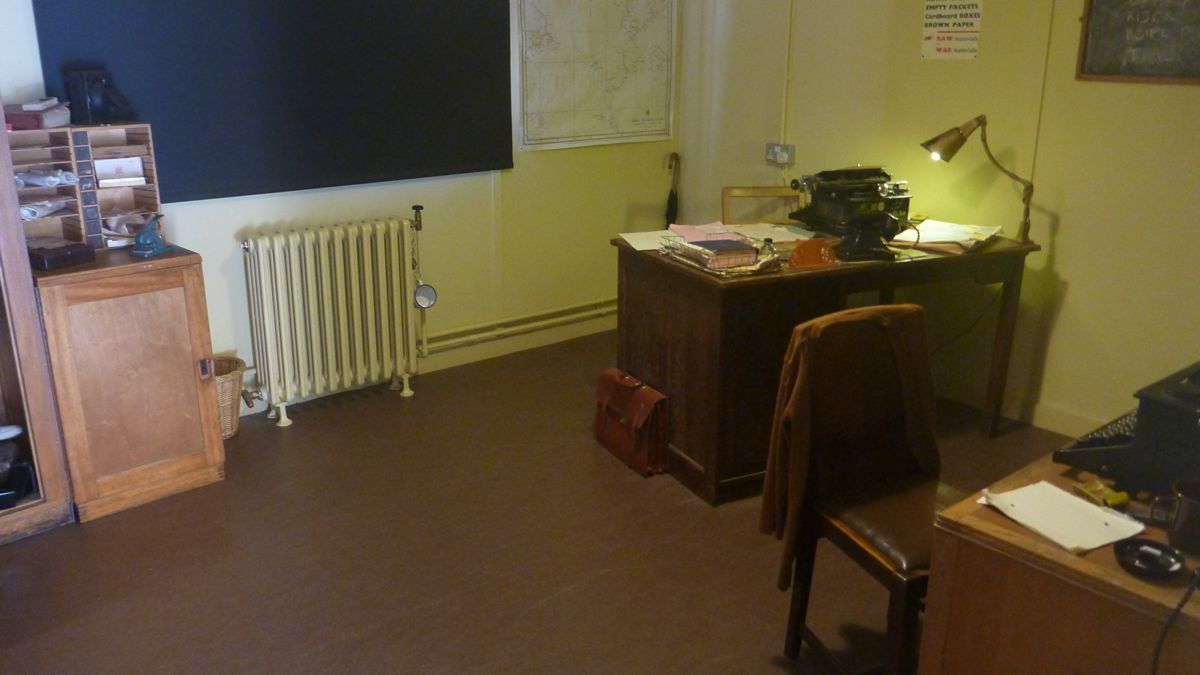
Turing’s desk is set up like he’d stepped away for lunch, as evidenced by the handwritten note scrawled onto the piece of paper in his typewriter.
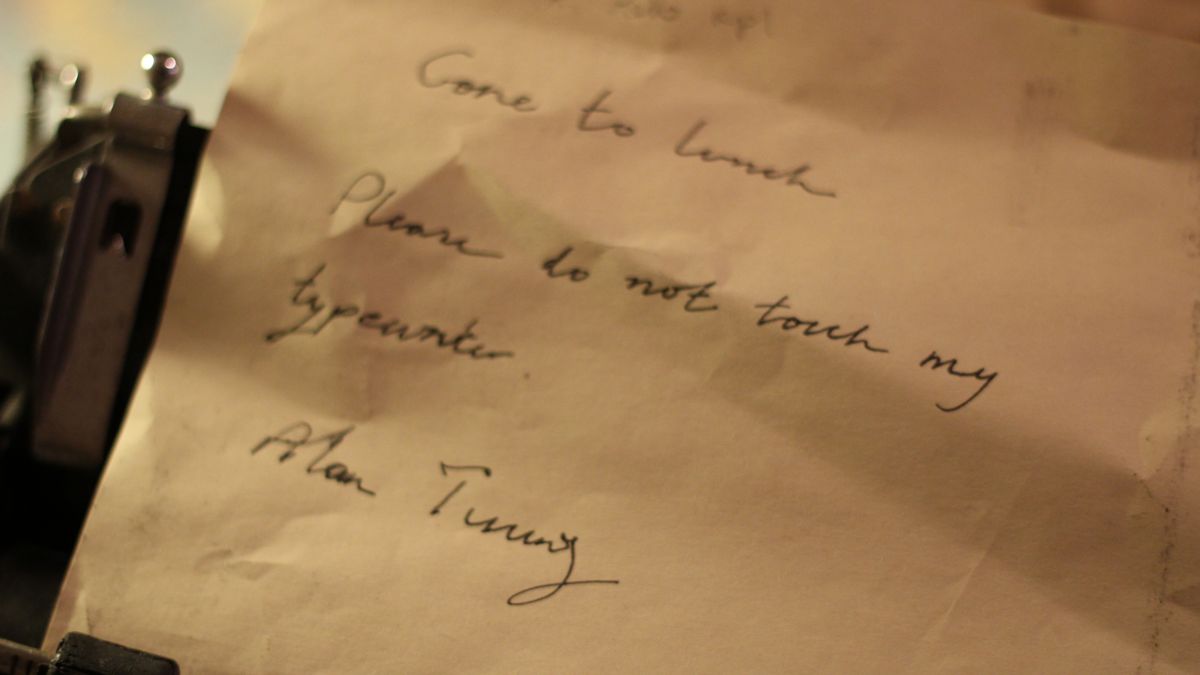
Is this really his actual typewriter or his actual handwriting? I can’t say for sure, but I appreciate the level of detail all the same. I was especially fond of Alan Turing’s personal coffee cup, which he kept chained to the radiator next to his desk to prevent it from disappearing.

Hut 8 also showcased a small exhibit showing off how pigeons were used in World War II. We didn’t spend too much time at that one, though. The day was getting late and we wanted to visit The Mansion before the museum closed.
The Mansion
The Mansion, which everyone called The Main House, dates back to the 1870s, but it got its current look about 1906 when then-owner Sir Herbert Leon built a new front entry and redecorated the interiors.
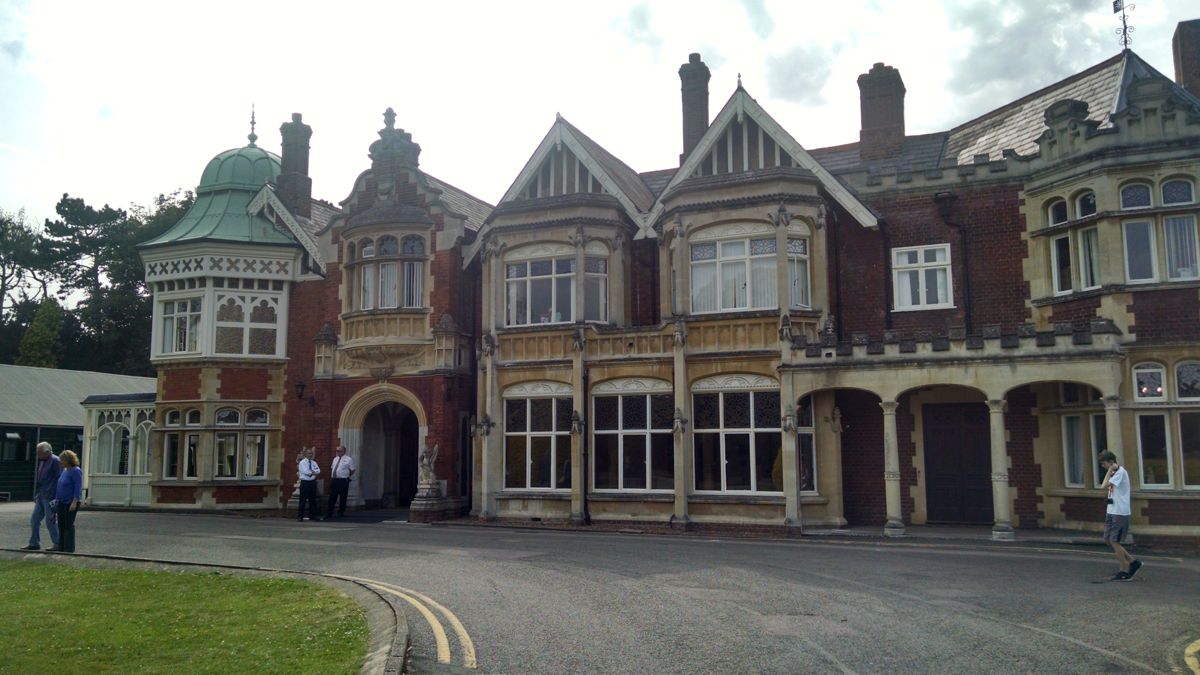
The Mansion was where Alistair Denniston, the first head of the Government Code & Cipher School, kept his office during his time at Bletchley Park. In an early memo, Commander Denniston stated that he felt the greatest detriment to the work being done at Bletchley Park was the lack of a place for the staff to play. So the Mansion and the surrounding grounds became the place where the hardworking employees living here would come to relax.
By the time we walked up the road to the Mansion, the museum was closing, so we didn’t spend a lot of time exploring the Mansion’s interior. Consequently, we missed seeing Denniston’s preserved office in what was known as The Morning Room. But we did take a look at the library, which was decorated like a World War II naval intelligence office.
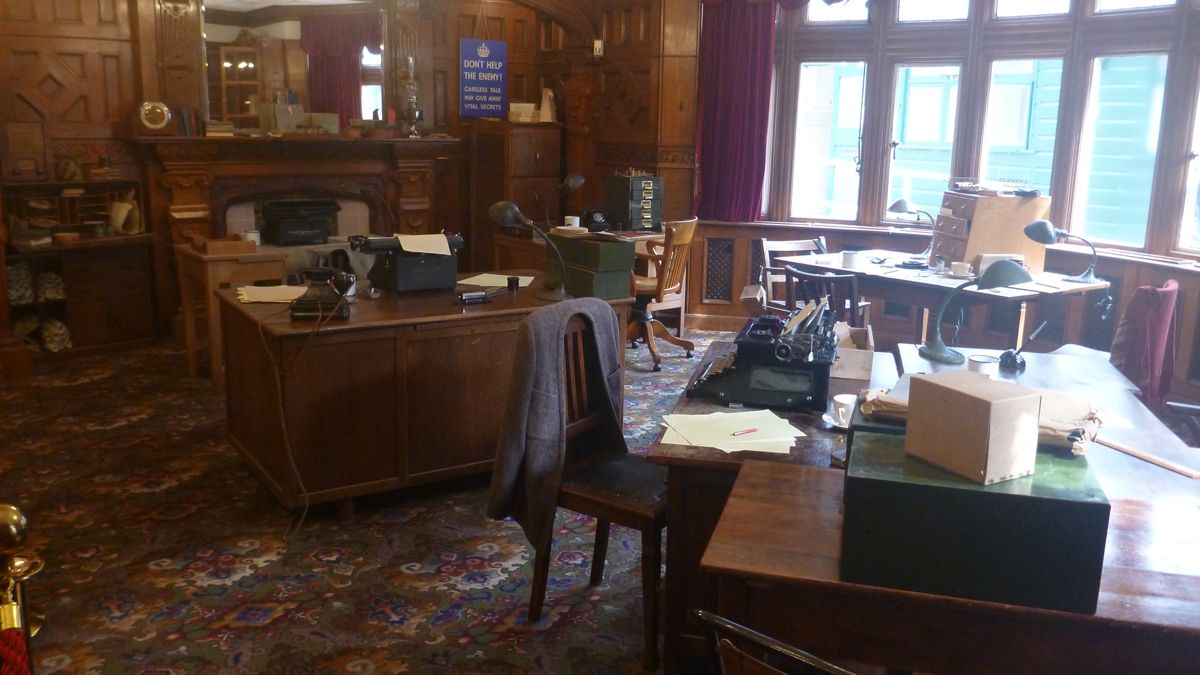
Notice the poster in the background advising the reader to “Don’t Help the Enemy! Careless talk may give away vital secrets!” emphasizing the intense level of secrecy the codebreakers were held to.
Other Huts
Visitors can also visit Huts 1, 3, 4, 6, 11, and 12, each of which offers a look into what life and work was like for the codebreakers of Bletchley Park. There are also a lot of other features that remain from Bletchley Park’s heyday, like a wartime garage and a collection of bicycles that workers used to travel around the sprawling complex.
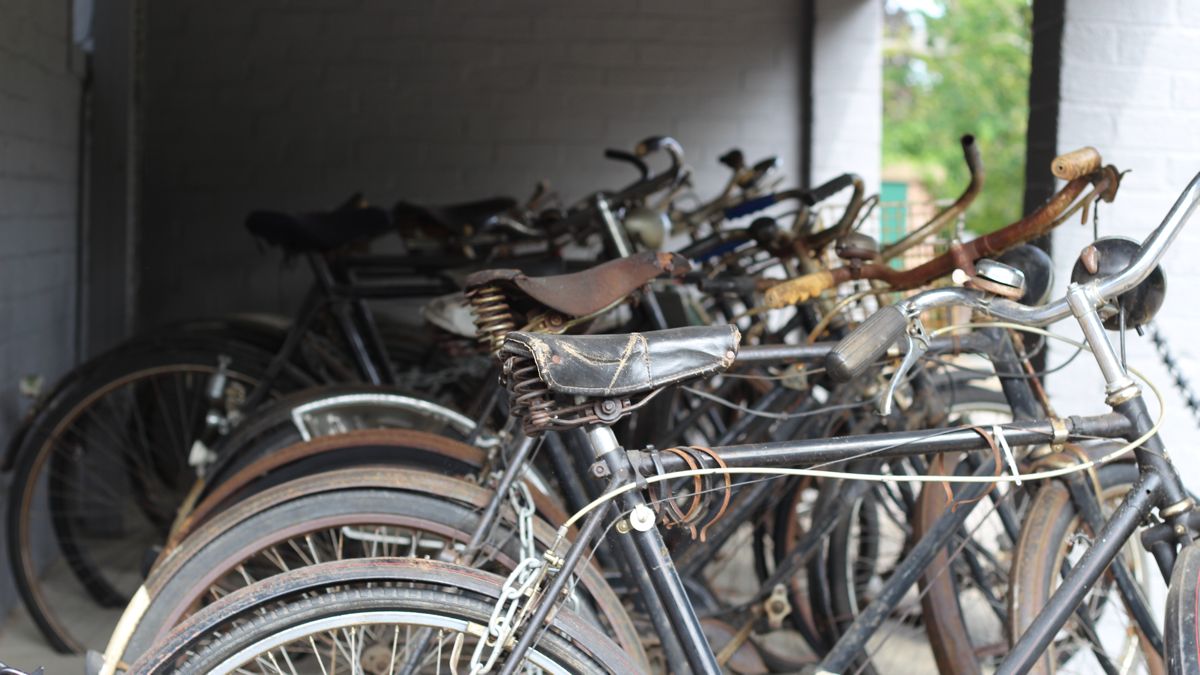
There is so much to see at Bletchley Park, it’s almost impossible to take it all in during a single visit. We only allowed ourselves about half a day here, so we didn’t come close to seeing it all. If you plan on going, give yourself enough time to thoroughly explore this fascinating place. You can even plan on spending a few days there if you’d like–one of the cool things about this museum is that your ticket is good for 12 months.
Learn More
If you want to learn more about Bletchley Park, I recommend The Bletchley Park Codebreakers by Ralph Erskine & Michael Smith. For younger readers, check out Secret Breakers Book 1: The Power of Three by H.L. Dennis, where the characters visit Bletchley Park to solve a mysterious code.
While we were there, the museum was promoting The Imitation Game, a movie starring Benedict Cumberbatch as Alan Turing that’s set in Bletchley Park, and the 2002 film Enigma (starring Kate Winslet and Dougray Scott) also takes place on the grounds of the estate.
All photos by the author.


Tom, I absolutely LOVED this post. Thanks for the details and the great photos.
Thanks, James! I’m glad you liked it. It’s really a great place to visit, and we look forward to going again so we can see the sections we has to miss.